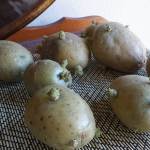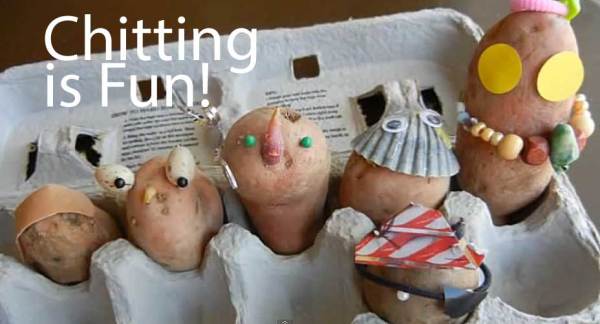Chit Potatoes
Is chitting just busy work for passionate gardeners?
Honest gardening folk would NEVER waste time doing mindless chores to avoid grocery shopping, cleaning the house or paying bills.
Is chitting necessary? It is NOT. So why should I prepare my spud before it hits the mud? There’s lots of talk about chitting but I want to know why it’s so fitting? You can chat while you chit. Watch them while you sit. Here are the real reasons – before you throw a fit!
3 Reasons to Chit Potatoes
- YOU LIKE THE IDEA: Chitting is the activity of pre-sprouting before planting. There are loads of experienced gardeners that chit their potatoes and loads more that don’t. The naysayers contend it’s unnecessary and insist that it doesn’t matter in terms of time or quality. Still, some of us like to experiment and dote on our vegetables. Seeing the potato sprout before we plant makes us feel all warm and cozy inside. Kids think it’s fun. Our parents may have chitted and if they chit, it makes you want to chit, just a bit.
- CHITTING MAY GIVE YOU A HEAD START: Do you live in a zone where hot weather slams into spring all of a sudden and there’s no turning back? I do. Spring and early summer are short-lived. The usual time to plant potatoes is after any threat of frost is past and when soil temps are in the 50’s. Pre-sprouting gets your taters off to a good start and allows them enough time to grow before it gets hot. Chitting for folks in warmer climates saves us about 10-14 days. In the gardening world that’s a chunk of the planting calendar. Some potatoes take longer to mature (20 weeks or more) and therefore it becomes even more important to get a head start.
- YOU’RE NOT A COMMERCIAL GROWER: Professional potato farmers do not chit, and for good reason. Chitting potatoes takes up space and time and that to a commercial grower costs money and cuts production. And how would they ship pre-sprouted potatoes? Commercial growers have the process down to an efficient science. They control timing and conditions and we do not usually run our home gardens the same way. We don’t consider chitting such an inconvenience. By coaxing shoots to emerge unharmed, they get strong before they get exposed to weather and soil issues. Sprouting does age the potato seed but if we are harvesting fine yields after chitting, why stop? Chitting is a centuries old practice and although commercial operations or science may not fully support it, there are some of us that believe it provides an advantage. And it’s fun!
 How to Chit Potatoes – TOO SIMPLE!
How to Chit Potatoes – TOO SIMPLE!
COOL SPOT WITH INDIRECT LIGHT: Six weeks before you plant outside, put your taters in a cool and bright location inside so the eyes will grow sprouts/chits. Position them so that most of the eyes are facing up. Make sure to not let them touch. (I’ve used an egg carton before to hold them in place.) If one potato turns bad you don’t want others to “catch the crud”. If the skin gets wrinkly that doesn’t mean the potato is going bad. let it be. Chitting does age the potato seed a bit. I like planting things that have just as many wrinkles as I do! Keep your sprouting spuds cool. A well-heated room with direct sun is not the best spot. I have mine in a cool room on the windowsill with plenty of space between.
SO STOP KNITTING AND GET TO CHITTING!
Count 6 weeks back from the dates below to start chitting your potatoes:
PLANT POTATOES IN THE GROUND
- US ZONE 1: Feb-May
- US ZONE 2: Apr-Jun
- US ZONE 3: Apr 15-Jun 1
- US ZONE 4: Apr 15-Jun 1
- US ZONE 5: Apr 1-15
- US ZONE 6: Apr 1-15
- US ZONE 7: Jan 15-Mar 1 (Aug 1-15 Fall)
- US ZONE 8: Jan 15-Mar 1
- US ZONE 9: Jan-Mar
- US ZONE 10: Jan-Feb



